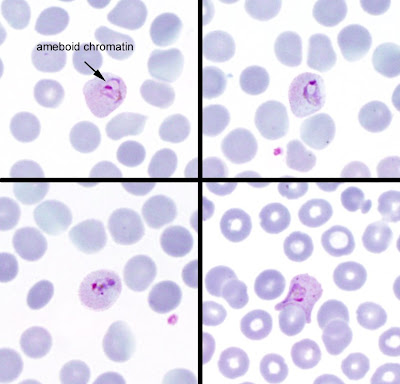This was a somewhat difficult case, in that you had to differentiate this species of malaria-causing parasite from the similar appearing and closely related species P. vivax. With both infections, the parasites invade young RBCs, so the infected cells are enlarged compared to the neighboring RBCs, and prominent cytoplasmic stippling is present. The difference lies mostly in the chromatin pattern. In P. vivax, the chromatin is referred to as "ameboid" (also spelled amoeboid). In contrast, the chromatin of P. ovale is less ameboid, and typically more compact. RBCs infected with P. ovale also classically have an oval shape, with a jagged or fimbriated edge, although this is less reliable. Finally, the schizonts of P. vivax contain 12-24 merozoites, whereas the schizonts of P. ovale contain only 6-12 merozoites. The images below demonstrate some of these key differences.
P. ovale

P. vivax

Lastly, the travel history of the patient is important in confirming the morphologic diagnosis. This patient had traveled to the Philippines, which is known to be endemic for P. ovale. This species is also found in Sub Saharan Africa, New Guinea, and parts of SE Asia.



No comments:
Post a Comment